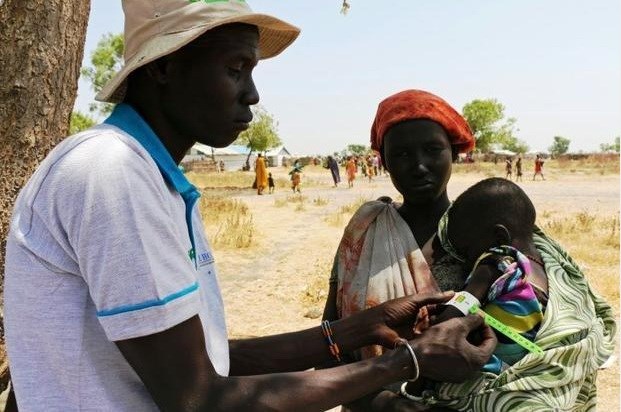Digital Journal
Sunday March 5, 2017

Four regions in Africa were singled out last month by the U.N. General-Secretary in a $4.4 billion appeal to avert catastrophic starvation and death. The four regions also share a common thread tying them to their circumstances - violent conflict.
Populations in Somalia, along with northeast Nigeria, South Sudan, and Yemen, are all facing food insecurity to one degree or another due to an ongoing drought, failed crops and internal violence. These problems have forced people to flee their villages and sometimes even their countries in order to find food, clean drinking water, and personal safety.
Humanitarian organizations have been begging for monetary help, and even though some funds have come in, it always seems to never be enough as the problem escalates. It is always difficult to read about children dying of hunger or thirst, but that is exactly what is happening today. Follows is an update from the four regions.
Somalia - 110 die of hunger in 48 hours
At a meeting Saturday morning of the Somalia National Drought Committee, Prime Minister Hassan Ali Khaire announced the first drought-related death toll in the nation since the Somalia government declared a national disaster on Tuesday. The UN estimates that 6.2 million people are at risk of starvation out of a population of 10.8 million.
“I was informed today that more than 110 people have died due to the current drought only for the past 48 hours in parts of Somalia, particularly Bay and Bakol regions,” Khaire said at a press conference Saturday in Mogadishu, reports Voice of America.
Since 2012, when an internationally supported government was established, Somalia has been inching toward stability, however, there is still violence from the Al-Qaeda-aligned Al-Shabab insurgents to deal with. While many people have fled to Mogadishu seeking food, water, and shelter, people in Al-Shabab-held villages are without help or international aid assistance.
Lake Chad Basin hard hit by Boko Haram and starvation
The Lake Chad Basin includes northeast Nigeria, Cameroon, Chad, and Niger, and is home to 7.1 million people and an additional 2.76 million internally displaced people. Continued violence by Boko Haram as well as counterinsurgency operations by the Nigerian government has been the reason for additional population movements that have put added stress on host communities forced to feed the newcomers.
The director of the Emergency and Rehabilitation Division, FAO, Dominique Burgeon told the Vanguard that with almost 90 percent of the population in the basin being farmers, the continued violence has kept them from planting crops or harvesting anything they were able to plant.
He said: “In the worst-affected areas, famine continues to loom — and millions will remain trapped in cycles of severe hunger if we don’t enable farmers to start cropping now." But the UN also cautions that if the cycle of violence isn't stopped, economic stability will never be realized and over 515,000 will be at risk of starvation or even death.
South Sudan's civil war fuels famine and refugee crisis
Acting U.S. State Department spokesman Mark Toner said in a statement on February 20 that the South Sudan crisis is man-made, calling the famine “the direct consequence of a conflict prolonged by South Sudanese leaders who are unwilling to put aside political ambitions for the good of their people.”
The population in South Sudan are fleeing rebel and government troops alike, and over 740,000 have already fled to neighboring Uganda where they live in refugee camps that are already strained. The UN says many have already died from hunger and another 100,000 people are on the brink of starvation. More than 4.9 million people need food assistance immediately.
Again, like in the Lake Chad Basin region, farmers have been unable to plant crops because of the civil war, while many families have dropped everything to flee to safety, leaving behind what little they had in the first place. To add to the crisis, the government has refused to let aid agencies inside the borders.
South Sudan is also on the verge of an all-out genocide, yet many observers are saying the world is just sitting on the sidelines, watching to see what will happen. Others suggest that there are limits to what other countries are allowed to do even with perceived government atrocities being committed. It is a strange situation and the only people who will suffer are the citizens.
Yemen and the world are at war as the population suffers
Yemen is a country in chaos. The UN's Under-Secretary-General for Humanitarian Affairs and Emergency Relief Coordinator, Stephen O’Brien wrapped up a five-day mission to Yemen the other day, saying life-saving humanitarian programs need to be implemented immediately in the war-torn country.
“We need more than funds. We also need all parties to the conflict to immediately facilitate timely, full and unimpeded humanitarian access,” Mr. O’Brien said. “More suffering and the specter of famine is encroaching on the very people the parties claim to be fighting for – the time is now to prove their seriousness. This includes access to cities, ports and the reopening of airports and airspace.”
The humanitarian crisis escalated in 2015, and now, almost 19 million people, two-thirds of the population are facing starvation. O'Brian said that over 7 million people don't even know where they will find their next meal. And it is not just food that is needed, but medical aid. Over 500,000 children are now at risk of starvation and a child is dying every 10 minutes. "However bleak the outlook, there is still time to alleviate suffering and avert a famine in Yemen,” Mr. O’Brien said at the conclusion of his third mission to Yemen as the UN relief chief.
v